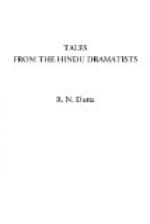The messenger of Ravana then goes away mortified to represent the matter to the minister of Ravana. The saint and his visitors then retire into the hermitage.
Malyavan, the minister and maternal grandfather of Ravana and the king’s sister Surpanakha have heard the news of Rama’s wedding with Sita from Siddhasrama and discuss the consequences with some apprehension. The minister takes the marriage as an insult to his master.
A letter arrives from Parasurama partly requesting and partly commanding Ravana to call off some of his imps, who are molesting the sages in Dandakaranya. He writes from Mahendra Dwipa.
Malyavan takes advantage of this opportunity to instigate a quarrel between the two Ramas, anticipating that Parasurama, who is the pupil of Siva, will be highly incensed when he hears of Rama’s breaking the bow of that divinity. The hero comes to Videha, the palace of Janaka, to defy the insulter of his god and preceptor. He enters the interior of the palace, the guards and attendants being afraid to stop him, and calls upon Rama to show himself. The young hero is proud of Parasurama’s seeking him and anxious for the encounter but detained awhile by Sita’s terrors: at last the heroes meet. Parasurama alludes to his own history how he, having overcome his fellow-pupil, Kartikeya, in a battle-axe fight, received his axe from his preceptor, Siva, as the prize of his prowess.
Parasurama addresses Rama thus:—
“How dost thou presume to bend thy brow in frowns on me? Thou must be an audacious boy, a scion of the vile Kshatriya race. Thy tender years and newly wedded bride teach me a weakness I am not wont to feel.
Throughout the world the story runs, I, Rama, and the son of Jamadgni, struck off a mother’s head with remorseless arm. This vengeful axe has one and twenty times destroyed the Kshatriya race, not sparing in its wrath the unborn babe hewn piecemeal in the parent womb.
It was thus I slaked the fires of a wronged father’s wrath with blood, whose torrents, drawn unsparingly from martial veins, fed the vast reservoir in which I love to bathe.”
Rama replies thus:—
“Give over thy vaunts—I hold thy cruelty a crime, not virtue.”
The combat between the two Ramas is suspended by the arrival of Janaka and Satananda, and Rama’s being summoned to attend the Kanchana Mochana, the loosening of Sita’s golden bracelet.
Parasurama awaits Ramachandra’s return. He is accosted in succession by Vasishtha, Viswamitra, Satananda, Janaka and Dasaratha, who first endeavour to soothe and then to terrify him; but he outbullies them all: at last Ramachandra returns from the string-removing ceremony and is heard calling on Parasurama, and the combat ensues. Ramachandra comes out victorious.




